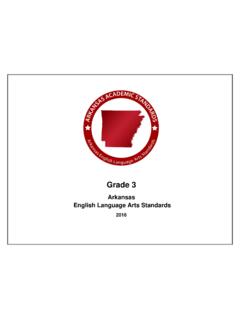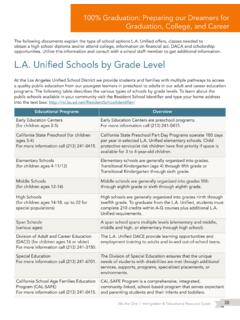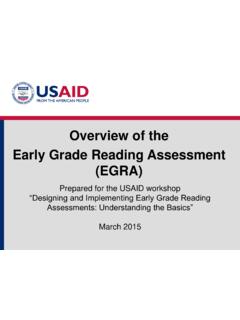Transcription of revised K-4 Science Standards Topic Arrangement
1 Realigned Fall 2016 to the Arkansas Mathematics Standards and Arkansas English Language Arts Standards Grades K-4 2015 1 Grades K-4 Arkansas K-12 Science Standards Arkansas Department of Education 2015 Table of Contents How to Read the Grades K-4 Science Core Ideas and Science K-4 Kindergarten Learning Progressions and Standards Forces and Interactions: Pushes and Pulls .. 11 Weather and Climate .. 13 Interdependent Relationships in Ecosystems: Animals, Plants, and Their Environment .. 15 Engineering, Technology, and Applications of Science .. 17 grade One Learning Progressions and Standards Waves: Light and Sound.
2 22 Structure, Function, and Information Processing .. 24 Space Systems: Patterns and Cycles .. 26 Engineering, Technology, and Applications of Science .. 27 grade Two Learning Progressions and Standards Structure and Properties of Matter .. 32 Interdependent Relationships in Ecosystems .. 34 Earth s Systems: Processes that Shape the Earth .. 36 Engineering, Technology, and Applications of Science .. 38 grade Three Learning Progressions and Standards Forces and Interactions .. 43 Interdependent Relationships in Ecosystems .. 45 Inheritance and Variation of Traits: Life Cycles and Traits .. 47 Weather and Climate.
3 49 Engineering, Technology, and Applications of Science .. 51 grade Four Learning Progressions and Standards Structure, Function, and Information .. 56 Waves: Waves and Information .. 57 Energy .. 59 Earth s Systems: Processes that Shape the Earth .. 62 Engineering, Technology, and Applications of Science .. 64 Contributors .. 66 How to Read Arkansas K-12 Science Standards 2 Grades K-4 Arkansas K-12 Science Standards Arkansas Department of Education 2015 Grades K-4 Science Core Ideas and topics Kindergarten PHYSICAL sciences LIFE sciences EARTH and SPACE sciences K. Forces and Interactions: Pushes and Pulls K.
4 Interdependent Relationships in Ecosystems: Animals, Plants, and Their Environment K. Weather and Climate grade 1 PHYSICAL sciences LIFE sciences EARTH and SPACE sciences 1. Waves: Light and Sound , Function, and Information Processing Systems: Patterns and Cycles grade 2 PHYSICAL sciences LIFE sciences EARTH and SPACE sciences and Properties of Matter Relationships in Ecosystems s Systems: Processes that Shape the Earth ENGINEERING, TECHNOLOGY, and APPLICATIONS of Science K-2. Engineering Design grade 3 PHYSICAL sciences LIFE sciences EARTH and SPACE sciences and Interactions Relationships in Ecosystems and Variation of Traits and Climate grade 4 PHYSICAL sciences LIFE sciences EARTH and SPACE sciences , Function, and Information Processing s Systems: Processes that Shape the Earth ENGINEERING, TECHNOLOGY, and APPLICATIONS of Science 3-4.
5 Engineering Design 5 Grades K-4 Arkansas K-12 Science Standards Arkansas Department of Education 2015 Arkansas K-12 Science Standards Overview The Arkansas K-12 Science Standards are based on A Framework for K-12 Science Education (NRC 2012) and are meant to reflect a new vision for Science education. The following conceptual shifts reflect what is new about these Science Standards . The Arkansas K-12 Science Standards reflect Science as it is practiced and experienced in the real world, build logically from Kindergarten through grade 12, focus on deeper understanding as well as application of content, integrate practices, crosscutting concepts, and core ideas, and make explicit connections to literacy and math.
6 As part of teaching the Arkansas K-12 Science Standards , it will be important to instruct and guide students in adopting appropriate safety precautions for their student-directed Science investigations. Reducing risk and preventing accidents in Science classrooms begin with planning. The following four steps are recommended in carrying out a hazard and risk assessment for any planned lab investigation: 1) Identify all hazards. Hazards may be physical, chemical, health, or environmental. 2) Evaluate the type of risk associated with each hazard. 3) Write the procedure and all necessary safety precautions in such a way as to eliminate or reduce the risk associated with each hazard.
7 4) Prepare for any emergency that might arise in spite of all of the required safety precautions. According to Arkansas Code Annotated 6-10-113 (2012) for eye protection, every student and teacher in public schools participating in any chemical or combined chemical-physical laboratories involving caustic or explosive chemicals or hot liquids or solids is required to wear industrial-quality eye protective devices (eye goggles) at all times while participating in Science investigations. The Arkansas K-12 Science Standards outline the knowledge and Science and engineering practices that all students should learn by the end of high school.
8 The Standards are three-dimensional because each student performance expectation engages students at the nexus of the following three dimensions: Dimension 1 describes scientific and engineering practices. Dimension 2 describes crosscutting concepts, overarching Science concepts that apply across Science disciplines. Dimension 3 describes core ideas in the Science disciplines. Science and Engineering Practices The eight practices describe what scientists use to investigate and build models and theories of the world around them or that engineers use as they build and design systems. The practices are essential for all students to learn and are as follows: 1.
9 Asking questions (for Science ) and defining problems (for engineering) 2. Developing and using models 3. Planning and carrying out investigations 4. Analyzing and interpreting data 5. Using mathematics and computational thinking 6. Constructing explanations (for Science ) and designing solutions (for engineering) 7. Engaging in argument from evidence 8. Obtaining, evaluating, and communicating information Crosscutting Concepts The seven crosscutting concepts bridge disciplinary boundaries and unit core ideas throughout the fields of Science and engineering. Their purpose is to help students deepen their understanding of the disciplinary core ideas, and develop a coherent, and scientifically based view of the world.
10 The seven crosscutting concepts are as follows: 1. Patterns- Observed patterns of forms and events guide organization and classification, and prompt questions about relationships and the factors that influence them. 2. Cause and effect- Mechanism and explanation. Events have causes, sometimes simple, sometimes multifaceted. A major activity of Science is investigating and explaining causal relationships and the mechanisms 4 Grades K-4 Arkansas K-12 Science Standards Arkansas Department of Education 2015 by which they are mediated. Such mechanisms can then be tested across given contexts and used to predict and explain events in new contexts.














